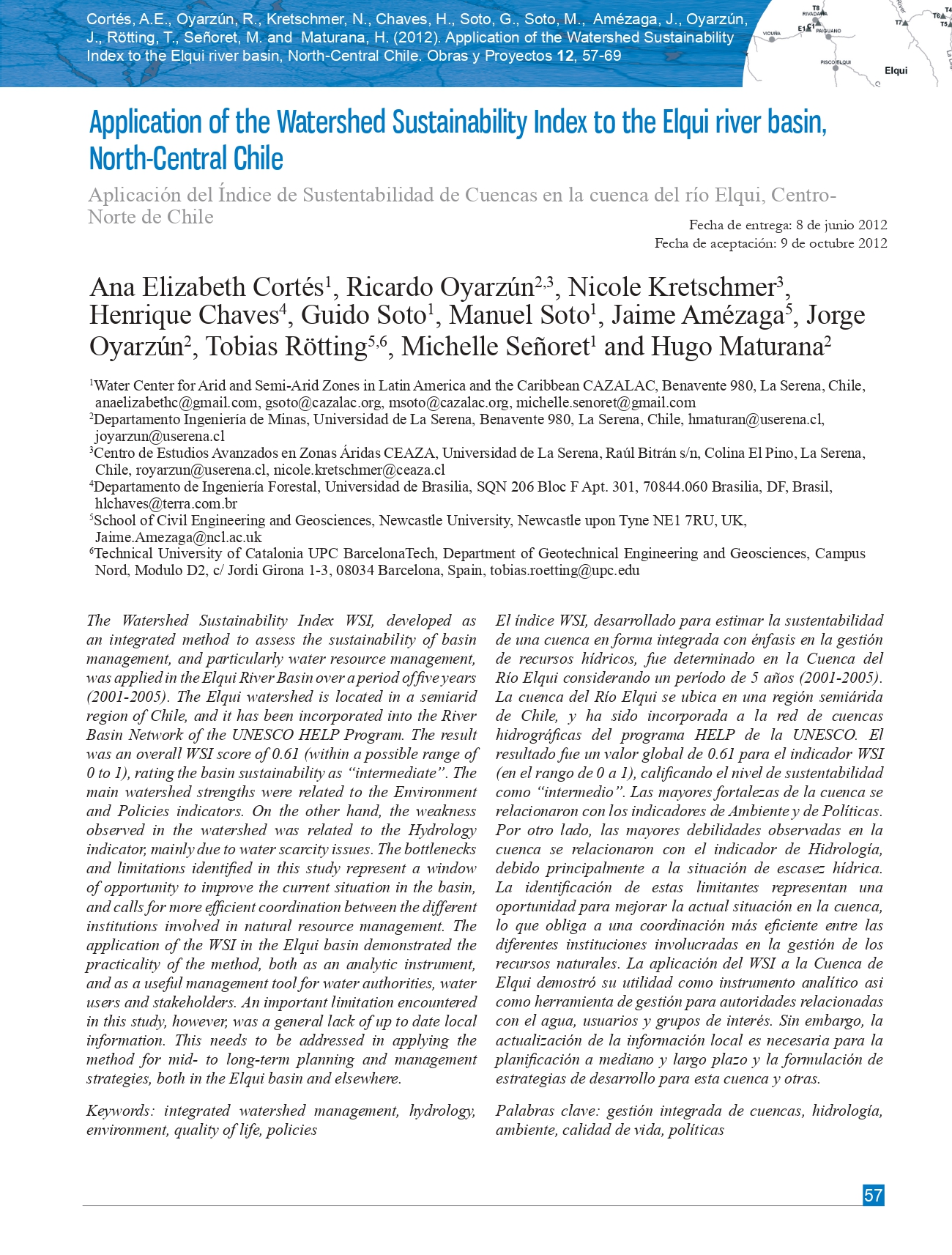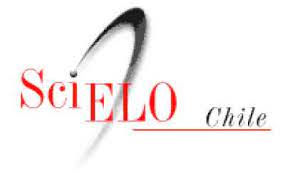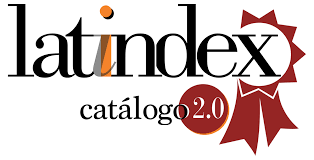Aplicación del Índice de Sustentabilidad de Cuencas en la cuenca del río Elqui, Centro-Norte de Chile
DOI:
https://doi.org/10.4067/S0718-28132012000200005Palabras clave:
gestión integrada de cuencas, hidrología, ambiente, calidad de vida, políticasResumen
El índice WSI, desarrollado para estimar la sustentabilidad de una cuenca en forma integrada con énfasis en la gestión de recursos hídricos, fue determinado en la Cuenca del Río Elqui considerando un período de 5 años (2001-2005). La cuenca del Río Elqui se ubica en una región semiárida de Chile, y ha sido incorporada a la red de cuencas hidrográficas del programa HELP de la UNESCO. El resultado fue un valor global de 0.61 para el indicador WSI (en el rango de 0 a 1), calificando el nivel de sustentabilidad como "intermedio". Las mayores fortalezas de la cuenca se relacionaron con los indicadores de Ambiente y de Políticas. Por otro lado, las mayores debilidades observadas en la cuenca se relacionaron con el indicador de Hidrología, debido principalmente a la situación de escasez hídrica. La identificación de estas limitantes representan una oportunidad para mejorar la actual situación en la cuenca, lo que obliga a una coordinación más eficiente entre las diferentes instituciones involucradas en la gestión de los recursos naturales. La aplicación del WSI a la Cuenca de Elqui demostró su utilidad como instrumento analítico asi como herramienta de gestión para autoridades relacionadas con el agua, usuarios y grupos de interés. Sin embargo, la actualización de la información local es necesaria para la planificación a mediano y largo plazo y la formulación de estrategias de desarrollo para esta cuenca y otras.
Referencias
Aldunce, P. and León, A. (2007). Opportunities for improving disaster management in Chile: a case study. Disaster Prevention and Management 16 (1), 33 - 41
Amézaga, J., Balvin, D., Abanto, C., Younger, P.L. and Rotting, T.S. (2007). ERMISA and CAMINAR Projects: Research on environmental Regulation, Catchment Management and Mining Impacts in South America. In R. Cidu and F. Frau (Eds) Water in Mining Environments. Mako Edizioni, Cagliari, 307 - 311
Araral, E. (2010). Improving effectiveness and efficiency in the water sector: Institutions, infrastructure and indicators. Water Policy 12 Supplement 1, 1 - 7
Brundtland, G.H. (1987). Our Common Future. The World Commission on Environment and Development. Oxford University Press, USA
Chaves, H.M.L. and Alipaz, S. (2007). An integrated indicator based on basin hydrology, environment, life, and policy: The watershed sustainability index. Water Resources Management 21(5), 883 - 895
Chilean Government (2009). Ley de Transparencia, por un Chile más transparente. Ley N° 20.285 sobre acceso a la información pública. Available at: http://www.leydetransparencia.gob.cl (Last accessed: May 2011)
CONAMA (2002). Estrategia Regional y Plan de Accion de la Biodiversidad IV Region de Coquimbo, Comisión Nacional del Medio Ambiente, Santiago, Chile.
CONAMA (2004). Guía CONAMA para el Establecimiento de las Normas Secundarias de Calidad Ambiental para Aguas Continentales Superficiales y Marinas. Comisión Nacional del Medio Ambiente, Santiago, Chile
CONAMA (2007). Estrategia Nacional de Gestion Integrada de Cuencas Hidrograficas. Comisión Nacional del Medio Ambiente, Santiago, Chile.
CONAMA (2009). Política para la Conservación y Protección de Glaciares. Comisión Nacional del Medio Ambiente, Santiago, Chile. Available at http://www.conama.cl/portal/1301/articles-45467_PoliticaGlaciales.pdf (Last accessed: December 2009)
Cortés, A.E. (2010). Determinación de un índice de sustentabilidad de cuencas (WSI) para la cuenca hidrográfica del río Elqui (CuencaHELP-UNECO). MSc Thesis, Universidad Católica del Norte, Coquimbo, Chile
Debels, P., Szlafsztein, C., Aldunce, P., Neri, C., Carvajal, Y., Quintero-Angel, M., Celis, A., Bezanilla, A. and Martínez, D. (2008). IUPA: a tool for the evaluation of the general usefulness of practices for adaptation to climate change and variability. Natural Hazards 50 (2), 211 - 233
Espejo, L., Kretschmer, N., Oyarzún, J., Meza, F., Núñez, J., Maturana, H., Soto, G., Oyarzo, P., Garrido, M., Suckel, F., Amezaga, J. and Oyarzún, R. (2012). Application of water quality indices and analysis of the surface water quality monitoring network in semi-arid North Central Chile. Environmental Monitoring and Assessment 184 (9), 5571-5588
Galleguillos, G. (2004). Efectos de la Actividad Minera y de las obras hidraulicas en la calidad de las aguas del Rio Elqui y de sus afluentes. Memoria de Título, Ingeniero Civil Ambiental, Universidad de La Serena, La Serena, Chile
Galleguillos, G., Oyarzún, J., Maturana, H. and Oyarzún, R. (2008). Retención de arsénico en embalses: el caso del río Elqui, Chile. Ingeniería Hidráulica en Mexico 23, 29 - 36
Guevara, S., Oyarzún, J. and Maturana, H. (2006). Geoquímica de las aguas del río Elqui y de sus tributarios en el período 19751995: Factores naturales y efecto de las explotaciones mineras en sus contenidos de Fe, Cu, y As. Agricultura Técnica (Chile) 66 (1), 57 - 69
Hezri, A.A. and Hassan, M.N. (2006). Towards sustainable development? The evolution of environmental policy in Malasia. Natural Resources Forum 30 (1), 37 - 50
Higueras, P., Oyarzun, R., Oyarzún, J., Maturana, H., Lillo, J. and Morata, D. (2004). Environmental assessment of copper-gold-mercury mining in the Andacollo and Punitaqui districts, northern Chile. Applied Geochemistry 19 (11), 1855 - 1864
Hooper, B. (2010). River basin organization performance indicators: Application to the Delaware River basin commission. Water Policy 12, 461 - 478
INE (2007). Censo agropecuario. Instituto Nacional de Estadistica, Santiago, Chile. Available at: http://www.ine.cl/canales/chile_estadistico/censos_agropecuarios/censo_agropecuario_07.php (Last accessed: November 2009).
INE (2009). Estadística demográfica. Instituto Nacional de Estadistica, Santiago, Chile. Available at: www.ine.cl (Last acessed: November 2009)
INN (1987). Norma Chilena Oficial, Requisitos de Calidad de Agua para Diferentes Usos (NCh133.Of78). Instituto Nacional de Normalización, Santiago, Chile
Jannas, R.R., Bowers, T.S., Petersen, U. and Beane, R.E. (1999). High -sulfidation deposit types in the El Indio district, Chile. Society of Economic Geologists, Special Publication 7, 27 - 59
Kalthoff, N., Fiebig-Wittmaack, M., Meibner, C., Kohler, M., Uriarte, M., Bischoff-Gaub, I. and Gonzales, E. (2006). The energy balance, evapo-transpiration and nocturnal dew deposition of an arid valley in the Andes. Journal of Arid Environment 65 (3), 420 - 443
Ledoux, L., Mertens, R. and Wolff, P. (2005). EU sustainable development indicators: An overview. Natural Resources Forum 29 (4), 392 - 403
Llanca, J.C. y Miranda, E.E. (2003). Estudio de agua subterránea en la cuenca del río Elqui. Memoria de Título Ingeniero Civil Ambiental, Universidad de La Serena, La Serena, Chile
Lee, Y.J. and Huang, C.M. (2007). Sustainability index for Taipei. Environmental Impact Assessment Review 27 (6), 505 - 521
Lostarnau, C., Oyarzún, J., Maturana, H., Soto, G., Señoret, M., Soto, M., Rotting, T.S., Amezaga, J.M. and Oyarzún, R. (2011). Stakeholder participation within the public environmental system in Chile: Major gaps between theory and practice. Journal of Environmental Management 92 (10), 2470 - 2478
Machinea, J.L., Barcena, A. and Leon, A. (2005). Objetivos de Desarrollo del Milenio: una mirada desde America Latina y el Caribe. CEPAL, Santiago, Chile
Molle, F. and Mollinga, P. (2003). Water poverty indicators: Conceptual problems and policy issues. Water Policy 5, 529 - 544
OECD (2003). OECD environmental indicators: development, measurement and use. Organization for Economic Cooperation and Development. Paris, France.
Oyarzun, R., Ortega, L., Sierra, J., Lunar, R. and Oyarzun, J. (1998). Cu, Mn, and Ag mineralization in the Quebrada Marquesa Quadrangle, Chile: the Talcuna and Arqueros districts. Mineralium Deposita 33 (6), 547 - 559
Oyarzun, R., Lillo, J., Higueras, P., Oyarzún, J. and Maturana, H. (2004). Strong arsenic enrichment in sediments from the Elqui watershed, Northern Chile: industrial (gold mining at El Indio-Tambo district) vs. geologic processes. Journal of Geochemical Exploration 84 (2), 53 - 64
Oyarzun, R., Guevara, S., Oyarzún, J., Lillo, J., Maturana, H. and Higueras, P. (2006). The As-contaminated Elqui river basin: a long lasting perspective (1975-1995) covering the initiation and development of Au-Cu-As mining in the high Andes of northern Chile. Environmental Geochemistry and Health 28 (5), 431-443
Oyarzun, J., Maturana, H., Paulo, A. and Pasieczna, A. (2003). Heavy metals in stream sediments from the Coquimbo Region (Chile): Effects of sustained mining and natural processes in a semi-arid Andean basin. Mine Water and Environment 22, 155 - 161
Paskoff, R. (1993). Geomorphology of Semiarid Chile. Universidad de La Serena, La Serena, Chile.
Perlack, R.D., Ensminger, T. and Martínez, R. (2001). Guatemala strives for environmental and economic sustainability in the Rio Dulce Region. Natural Recources Forum 25, 235 - 244
Saravanan, V.S., McDonald, G.T. and Molling, P.P. (2009). Critical review of integrated water resources management: moving beyond polarised discourse. Natural Resources Forum 33 (3), 76 - 86
Squeo, F., Arancio, G. and Gutierrez, J. (2002). Libro rojo de la flora nativa y de los sitios prioritarios para su conservación: Región de Coquimbo. Universidad de La Serena, Corporacion Nacional Forestal y Gobierno Regional de Coquimbo. La Serena, Chile.
Sullivan, C.A. Meigh, J.R., Giacomello, A.M., Fediw, T., Lawrence, P., Samad, M., Mlote, S., Hutton, C., Allan, J.A., Schulze, R.E., Dlamini, D.J.M., Cosgrove, W., Delli Priscoli, J., Gleick, P., Smout, I., Cobbing, J., Calow, R., Hunt, C., Hussain, A., Acreman, M.C., King, J., Malomo, S., Tate, E.R., O'Regan, D., Milner, S. and Steyl, I. (2003). The Water Poverty Index: Development and application at the community scale. Natural Resources Forum 27 (3), 189 - 199
UNDP (1994). Informe sobre el Desarrollo Humano. Programa de la Naciones Unidas para el Desarrollo y Fondo Cultura Economica FCE, México
UNDP (2003). Las trayectorias del desarrollo humano en las comunas de Chile (1994-2003). Temas de desarrollo humano sustentable N° 11, Santiago, Chile
UNESCO (2008). Evaluación objetiva de la aplicación y cálculo del Índice de Sostenibilidad de Cuenca en la Cuenca Hidrográfica del Canal de Panamá. Documentos Técnicos del PHI-LAC, N° 12
UNESCO (2010). Guía metodológica para la aplicación del Análisis Regional de Frecuencia de Sequías basado en L-momentos y resultados de aplicación en América Latina. CAZALAC. Documentos Técnicos del PHI-LAC, N° 27. Available at: http://www.unesco.org/new/en/natural-sciences/environment/water/ihp/ihp-programmes/help/ (Last accessed: May 2011)
WHO (2008). Guidelines for Drinking-Water Quality. World Health Organization. Available at: http://www.who.int/watersanitation_health/dwq (Last acessed: December 2008)

Descargas
Publicado
Número
Sección
Licencia
Derechos de autor 2012 Universidad Católica de la Santísima Concepción

Esta obra está bajo una licencia internacional Creative Commons Atribución-NoComercial 4.0.







